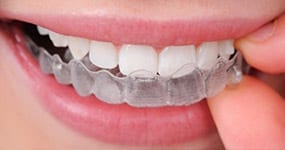What is an overbite and how is it corrected?

Put simply, an overbite is a misalignment of teeth, whereby the top front teeth overlap the bottom front teeth. Common in children and adults, this form of malocclusion can be a serious cause of concern from both an aesthetic and health perspective.
To help you on your journey to a more comfortable and confident smile, we’ve put together a complete guide to this orthodontic issue. Below, we explain what an overbite is, how it is caused and why it is important to address as early on as possible. Read on to discover more about overbites and their correction.
What is malocclusion?
Before we define an overbite, it’s important to understand what a malocclusion is. This term refers to misalignment of the teeth. There are three classes of malocclusion:
- Class one is when the upper front teeth slightly overlap the bottom teeth, but the bite is considered normal;
- Class two is a severe overbite or retrognathia, which occurs when the upper teeth overlap the lower teeth ; and
- Class three is a severe underbite or prognathia, whereby the lower teeth overlap the upper teeth.
What is an overbite?
An overbite occurs when the top teeth overlap the bottom teeth. While a minor overbite is normal and necessary for an effective bite, the upper teeth should not entirely conceal the lower teeth.
Orthodontists measure the extent of an overbite as a percentage of overlap between the upper and lower teeth. The greater the percentage, the more extreme the overbite and required treatment.
Usually, an overlap that exceeds two to three millimetres is categorised as an overbite and should be seen to by a skilled orthodontist.
The most severe overbite is an impinging overbite, whereby the lower teeth touch the roof of the mouth when closed. This gradually harms the bone supporting the top front teeth, which can be lost if left untreated.
What is an overbite versus overjet?
Whereas an overbite is characterised by a vertical overlap of the top teeth over the bottom teeth, an overjet is an outwards protrusion of the top front teeth beyond that of the bottom front teeth. This latter condition is often unkindly referred to as having ‘buck teeth’.
Patients with a significant overjet often have a severe overbite, too. At ABC Orthodontics, our experienced team can diagnose and address both concerns simultaneously.
What causes an overbite?
The two overarching types of overbite are skeletal and dental, with some patients presenting a combination of both.
A skeletal overbite is caused by genetic irregularities in jawbone development. Here, the shape and growth of your jaw produces a natural malocclusion. Additionally, overcrowding often leads to an overbite as the teeth struggle to find a place to grow.
In contrast, childhood behaviours like thumb sucking or prolonged use of a dummy cause a dental overbite. In later life, habits such as nail-biting often have the same consequence. These actions stimulate jaw movement and impact the front upper teeth on a regular basis, slowly but surely affecting their development and positioning.
What happens if an overbite is left untreated?
If ignored, an overbite can bring serious mental and physical health complications.
Firstly, a moderate to severe overbite can significantly alter the facial structure, with many patients reporting that a weak jawline is a source of low self-esteem.
However, the concerns associated with this type of malocclusion go far beyond aesthetics. Potential dental problems that may arise if an overbite goes untreated include:
Tooth decay
As teeth are misaligned in an overbite, their enamel gets grinded down over time. This excessive wear and tear increases the risk of tooth decay, fracture and infection, all of which can lead to tooth loss.
Difficulty eating and speaking
If the upper and lower jaw are aligned correctly, the top and bottom teeth cannot bite together properly. This can make it challenging to chew. Furthermore, enunciation requires the teeth, lips, and tongue to work in unison. If you have a prominent overbite, you may find it hard to pronounce certain words.
Jaw pain, neck pain and headaches
Poor jaw positioning over a prolonged period of time can lead to discomfort such as a stiff jaw, sore neck, earaches and headaches. If left untreated, this pain can intensify.
Temporomandibular joint (TMJ) disorders
TMJ disorders can develop if a severe overbite goes untreated. That’s because an overbite can cause the TMJ to cramp and increase the risk of its disc slipping forward, in turn leading to TMJ dysfunction. If this occurs, it will be tough to control your jaw and perform basic functions.
Periodontal disease and other conditions
Gums are not supposed to come into contact with your teeth as you bite. In some severe overbites, the bottom teeth strike the gum line behind the top teeth, which themselves damage the gum line in front of the lower teeth. Repeated impact can cause gum recession and disease.
Sleep apnoea
Overbites can increase the risk of developing obstructive sleep apnoea. As the lower jaw rests too far back relative to the upper jaw, the upper airways narrow while you sleep. This restricts airflow and ultimately disrupts your breathing.
Even with all the right dental care, the above complications can make it challenging to prevent problems that are avoidable with an aligned bite. That’s why it is so important to seek treatment as soon as possible if you have an overbite. Typically, the earlier you intervene, the stronger the result.
How to correct an overbite
If your dentist believes that your overbite requires treatment, they will generally refer you to an orthodontist.
Importantly, the orthodontic options for correcting an overbite will differ depending on your age. As a child’s teeth are still developing, they tend to be more responsive to intervention than an adult’s. This makes treatment less invasive, complex and time-consuming.
The orthodontist will also examine your mouth, teeth and jaw, taking X-rays to confirm the type and nature of the overbite. Afterwards, they will prepare a personalised treatment plan that recommends one of the following:
1. Braces
Braces can align a moderate overbite relatively quickly by straightening the teeth. Brackets, elastics, and wires work together to exert pressure on the teeth, causing them to shift into the desired position.
Crucially, braces are not a suitable orthodontic solution for skeletal overbites. This option is most appropriate for children, whose jawbone and teeth are still growing.
2. Clear aligners
If you would prefer a more subtle option, clear aligners like Invisalign can be used to correct a minor overbite. Depending on the severity of your malocclusion and the type of clear aligner chosen, results can be achieved in as little as six months.
4. Tooth extractions
Although we do not advise the extraction of adult teeth, baby teeth may be removed to make room for permanent teeth to grow straight. By preventing overcrowding, this can work to prevent an overbite moving forward.
5. Orthognathic surgery
Severe overbites may require orthognathic surgery. During this invasive procedure, the jaw is set into its desired position. An operation like this is more common for skeletal overbites in adults, as the teeth roots and bones have fully developed and are therefore less malleable.
Generally speaking, the most effective way to correct an overbite and prevent associated complications is to visit the dentist from a young age. It is advised that children attend their first dental checkup by age seven.
That way, if the dentist detects an overbite, they can refer you to an orthodontist for treatment. As discussed above, the earlier the orthodontic intervention, the less extreme it may need to be.
How long does it take to align an overbite?
The time it takes to correct an overbite depends on the extent of malocclusion and the type of treatment you undergo.
For instance, if you have a slight overbite, you may be able to achieve your desired results in just a few months. A severe overbite will take much longer to align.
The average time to correct an overbite with clear aligners is approximately nine to twelve months. In contrast, it tends to take one to three years to align an overbite with metal braces. Meanwhile, the estimated recovery time from surgery is usually six to eight weeks.
Book an appointment for overbite correction in Newcastle, NSW
So, what is an overbite? In a nutshell, an overbite is a misalignment of the teeth where the upper teeth protrude over the lower teeth.
If this malocclusion is not addressed in childhood while the jaw and teeth are still developing, serious health complications can occur. Therefore, if you have an overbite, an orthodontist should examine your mouth, teeth and jaw to determine the best course of action for your oral wellbeing.
To book an orthodontic appointment in Newcastle, please get in touch with the friendly team at ABC Orthodontics today on 1300 794 797. We look forward to welcoming you to our practice!



